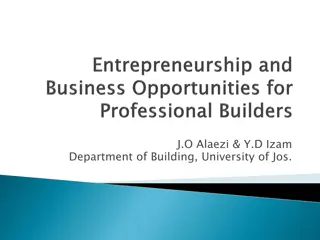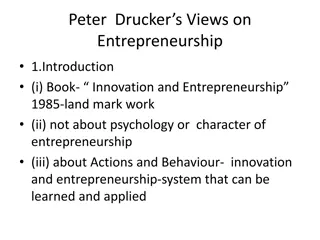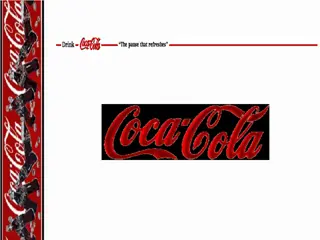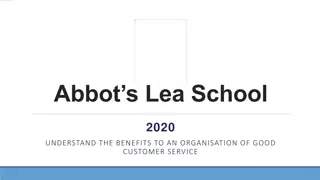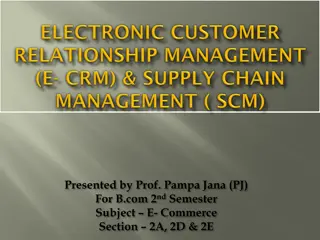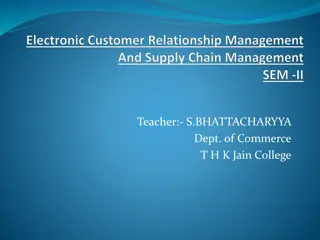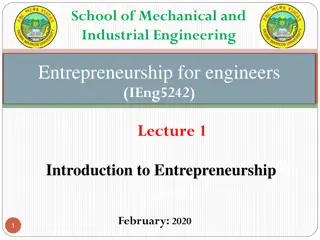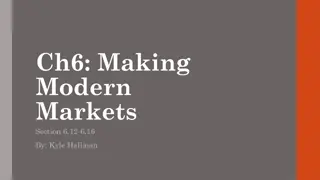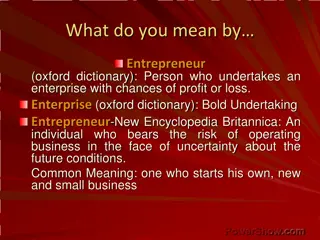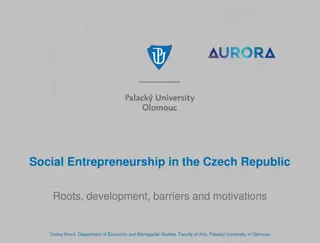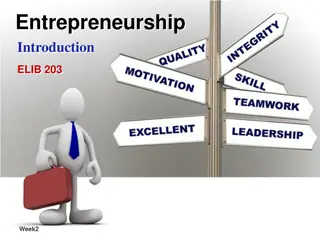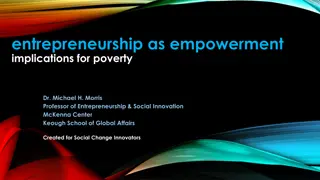Understanding Cost of Customer Acquisition (COCA) in Entrepreneurship
Cost of Customer Acquisition (COCA) is a crucial metric in entrepreneurship that calculates how much it costs to acquire a new customer. This metric involves quantifying all sales and marketing expenses related to attracting a customer, emphasizing the importance of understanding the sales process and making realistic calculations to ensure business sustainability. The COCA vs. LTV comparison highlights the significance of balancing acquisition costs with customer lifetime value for business success.
Download Presentation

Please find below an Image/Link to download the presentation.
The content on the website is provided AS IS for your information and personal use only. It may not be sold, licensed, or shared on other websites without obtaining consent from the author. Download presentation by click this link. If you encounter any issues during the download, it is possible that the publisher has removed the file from their server.
E N D
Presentation Transcript
Entrepreneurship for Computer Science CS 15-390 COCA Lecture 12, February 20, 2018 Mohammad Hammoud
Today Last Session: Quiz I Today s Session: COCA Announcements: PS2 and Quiz I grades are out CP1 is due on Feb 27 by midnight. Each team will be given 12 minutes to present its findings in class. Midterm is on March 13.
Cost of Customer Acquisition (COCA) My COCA is $10 is $10 Mine is more Mine is more awesome than yours awesome than yours Mine is $5!!! Mine is $5!! My COCA
Cost of Customer Acquisition (COCA) This always happens. I will get them out of here and back to reality tomorrow when they sober up. My COCA is $10 is $10 Mine is more Mine is more awesome than yours awesome than yours Mine is $5!!! Mine is $5!! My COCA Optimism is good, but be careful not to blind you from the real cost of customer acquisition. It is essential that you do realistic calculations and then make appropriate adjustments over time.
Cost of Customer Acquisition (COCA) How much does it cost you to bring a new customer to your product? In other words, how much is your COCA? In calculating your COCA, you must quantify all the sales and marketing costs involved in acquiring a single average customer in steady state Examples of sales and marking costs include salesmen salaries, admin support, travel, entertainment, trade shows, phone, Internet, website developments, computers, etc., This necessitates that you understand your sales process very well! Production, R & D, finance and administrations, and any other overhead costs are not included
COCA vs. LTV For almost all new ventures, COCA will start very high and decrease over time (opposite to LTV) Point of Equilibrium LTV $ Cash-flow Negative Cash-flow Positive COCA Time
How to Calculate COCA? To calculate COCA, you need three metrics: 1. Total Marketing and Sales Expenses over Time or TMSE(t) 2. Install Base Support Expense over Time or IBSE(t) This is the cost to retain existing customers 3. New Customers over Time or NC(t) COCA = (TMSE(t) IBSE(t))/NC(t) COCA is typically calculated over 3 consecutive time periods, namely, short-term (e.g., 1st year of sales), medium-term (e.g., 2nd and 3rd years of sales), and long-term (e.g., 4th and 5th years of sales) periods Depending on your venture, these time periods may be different!
Example: Associated Gas Energy Oil drilling typically produces associated gas as well, which is costly to deal with and problematic for the environment Assume a new venture, namely, Associated Gas Energy, with a GTL (Gas To Liquid) technology to convert associated gas into crude oil at a cost of $70 to a conservative customer The customer can be convinced to buy using old-fashioned direct sales methods, especially at the beginning
Example: Associated Gas Energy Year 1 Plan: Hire an experienced sales person (say, full package at $175K/year) Hire a tech sales support person (say, full package at $125K/year) Hire a consultant to help break through the initial customer inertia and to get all regulatory issues taken care of (say, full package at $150K/year) Spend on travel (say, $24K), develop ad material (say, $15K), conduct a trade show (say, $30K), and develop a website (say, $10K) Expected number of customers is 1
Example: Associated Gas Energy Years 2 & 3 Plans: Fire the consultant since all regulatory issues will be resolved by then, let alone that the hardest sale (i.e., the first sale) will be done Hire one extra salesperson and another tech support person every year to increases sales Increase spending on travel, ad material, trade shows, and website maintenance Expected numbers of customers are 3 & 7 in years 2 & 3, respectively We will assume three time periods over only 3 years
Example: Associated Gas Energy COCA Calculation: Year 1 Year 1 Year 1 Year 1 Year 1 Year 1 Year 1 Year 1 Year 2 Year 2 Year 2 Year 2 Year 2 Year 2 Year 2 Year 2 Year 3 Year 3 Year 3 Year 3 Year 3 Year 3 Year 3 Year 3 Salespeople Salaries Salespeople Salaries Salespeople Salaries Salespeople Salaries Salespeople Salaries Salespeople Salaries Salespeople Salaries Salespeople Salaries $175K 1 = $175K $175K 1 = $175K $175K 1 = $175K $175K 1 = $175K $175K 1 = $175K $175K 1 = $175K $175K 1 = $175K $175K 1 = $175K $175K 2 = $350K $175K 2 = $350K $175K 2 = $350K $175K 2 = $350K $175K 2 = $350K $175K 2 = $350K $175K 2 = $350K $175K 2 = $350K $175K 3 = $525K $175K 3 = $525K $175K 3 = $525K $175K 3 = $525K $175K 3 = $525K $175K 3 = $525K $175K 3 = $525K $175K 3 = $525K Tech Support People Tech Support People Tech Support People Tech Support People Tech Support People Tech Support People Tech Support People Tech Support People Salaries Salaries Salaries Salaries Salaries Salaries Salaries Salaries $125 1 = $125K $125 1 = $125K $125 1 = $125K $125 1 = $125K $125 1 = $125K $125 1 = $125K $125 1 = $125K $125 1 = $125K $125 2 = $250K $125 2 = $250K $125 2 = $250K $125 2 = $250K $125 2 = $250K $125 2 = $250K $125 2 = $250K $125 2 = $250K $125 3 = $375K $125 3 = $375K $125 3 = $375K $125 3 = $375K $125 3 = $375K $125 3 = $375K $125 3 = $375K $125 3 = $375K Travel Travel Travel Travel Travel Travel Travel Travel $24,000 $24,000 $24,000 $24,000 $24,000 $24,000 $24,000 $24,000 $40,000 $40,000 $40,000 $40,000 $40,000 $40,000 $40,000 $40,000 $52,500 $52,500 $52,500 $52,500 $52,500 $52,500 $52,500 $52,500 Ad Material Ad Material Ad Material Ad Material Ad Material Ad Material Ad Material Ad Material $15,000 $15,000 $15,000 $15,000 $15,000 $15,000 $15,000 $15,000 $24,000 $24,000 $24,000 $24,000 $24,000 $24,000 $24,000 $24,000 $30,000 $30,000 $30,000 $30,000 $30,000 $30,000 $30,000 $30,000 Events Events Events Events Events Events Events Events $30,000 $30,000 $30,000 $30,000 $30,000 $30,000 $30,000 $30,000 $35,000 $35,000 $35,000 $35,000 $35,000 $35,000 $35,000 $35,000 $40,000 $40,000 $40,000 $40,000 $40,000 $40,000 $40,000 $40,000 Website Cost Website Cost Website Cost Website Cost Website Cost Website Cost Website Cost Website Cost $10,000 $10,000 $10,000 $10,000 $10,000 $10,000 $10,000 $10,000 $10,000 $10,000 $10,000 $10,000 $10,000 $10,000 $10,000 $10,000 $10,000 $10,000 $10,000 $10,000 $10,000 $10,000 $10,000 $10,000 Consultant Consultant Consultant Consultant Consultant Consultant Consultant Consultant $150,000 $150,000 $150,000 $150,000 $150,000 $150,000 $150,000 $150,000 $0 $0 $0 $0 $0 $0 $0 $0 $0 $0 $0 $0 $0 $0 $0 $0 TMSE TMSE TMSE TMSE TMSE TMSE TMSE TMSE TMSE(1) = $394,000 TMSE(1) = $394,000 TMSE(1) = $394,000 TMSE(1) = $394,000 TMSE(1) = $394,000 TMSE(1) = $394,000 TMSE(1) = $394,000 TMSE(1) = $394,000 TMSE(2) = $709,000 TMSE(2) = $709,000 TMSE(2) = $709,000 TMSE(2) = $709,000 TMSE(2) = $709,000 TMSE(2) = $709,000 TMSE(2) = $709,000 TMSE(2) = $709,000 TMSE(3) $1,032,500 TMSE(3) $1,032,500 TMSE(3) $1,032,500 TMSE(3) $1,032,500 TMSE(3) $1,032,500 TMSE(3) $1,032,500 TMSE(3) $1,032,500 TMSE(3) $1,032,500
Example: Associated Gas Energy COCA Calculation: Year 1 Year 1 Year 1 Year 1 Year 2 Year 2 Year 2 Year 2 Year 3 Year 3 Year 3 Year 3 TMSE TMSE TMSE TMSE TMSE(1) = $394,000 TMSE(1) = $394,000 TMSE(1) = $394,000 TMSE(1) = $394,000 TMSE(2) = $709,000 TMSE(2) = $709,000 TMSE(2) = $709,000 TMSE(2) = $709,000 TMSE(3) $1,032,500 TMSE(3) $1,032,500 TMSE(3) $1,032,500 TMSE(3) $1,032,500 NC NC NC NC NC(1) = 1 NC(1) = 1 NC(1) = 1 NC(1) = 1 NC(2) = 3 NC(2) = 3 NC(2) = 3 NC(2) = 3 NC(3) = 7 NC(3) = 7 NC(3) = 7 NC(3) = 7 IBSE IBSE IBSE IBSE IBSE(1) = $0 IBSE(1) = $0 IBSE(1) = $0 IBSE(1) = $0 IBSE(2) = $20,000 IBSE(2) = $20,000 IBSE(2) = $20,000 IBSE(2) = $20,000 IBSE(3) = $60,000 IBSE(3) = $60,000 IBSE(3) = $60,000 IBSE(3) = $60,000 COCA COCA COCA COCA COCA(1) = $394K COCA(1) = $394K COCA(1) = $394K COCA(1) = $394K COCA(2) = ($709K- $20K)/3 = $229.666K $20K)/3 = $229.666K $20K)/3 = $229.666K $20K)/3 = $229.666K COCA(2) = ($709K- COCA(2) = ($709K- COCA(2) = ($709K- COCA(3) = ($1,032,500- $60K)/7 = $138.928K $60K)/7 = $138.928K $60K)/7 = $138.928K $60K)/7 = $138.928K COCA(3) = ($1,032,500- COCA(3) = ($1,032,500- COCA(3) = ($1,032,500-
Example: Associated Gas Energy COCA TMSE IBSE NC 1200000 1000000 800000 600000 $ 400000 200000 0 Year 1 Year 2 Period Year 3
How To Reduce COCA? 1. While very powerful, use direct sales judiciously as it is very expensive Hiring a team to do direct sales may be necessary to start, but it is expensive Consider investing in technological enablers (e.g., telemarketing, effective web presence, social media, etc.,) Automate as much as possible via creating incentive schemes for your users to recruit others (e.g., Groupon & Uber) Multi-Level Marketing (MLM), whereby a company makes revenue from non- salaried workforce (called participants), who sell its products and earn via a pyramid-shaped commission system is controversial (e.g., Avon) Participant Two revenue streams: 1) Commissions on their sales 2) Commission on their downline distributors' sales Recruited Downline Distributors Receive commission on ONLY their sales
How To Reduce COCA? 2. Improve conversion rate in sales Not every desired deal is closed, although (huge) cost is usually associated with every chased deal Increasing your rate of closing deals (e.g., improving your conversion rate) compensates for costs and opens up the funnel for more deals to get through One way to achieve this is to decrease the cost and enhance the quality of leads (e.g., you can use HubSpot sinbound marketing strategy) 3. Choose your business model with COCA in mind Your business model might make it easier to sell your product to customers (e.g., IntraLink); hence, decreasing the sales cycle length
How To Reduce COCA? 4. Drive positive word-of-mouth This can improve you company s stature and let you easily cross the chasm towards the mainstream market Focus on your beachhead market and employ the viral engine of growth (more on this next week) One way to measure results is to use the Net Promoter Score or NPS How likely is it that you would recommend a product to a friend or colleague? Respondents can be categorized into three groups: 1) Promoters (score 9-10) are loyal enthusiasts who will keep buying and refer others, fueling growth
How To Reduce COCA? 4. Drive positive word-of-mouth This can improve you company s stature and let you easily cross the chasm towards the mainstream market Focus on your beachhead market and employ the viral engine of growth (more on this next week) One way to measure results is to use the Net Promoter Score or NPS How likely is it that you would recommend a product to a friend or colleague? Respondents can be categorized into three groups: 2) Passives (score 7-8) are satisfied but unenthusiastic customers who are vulnerable to competitive offerings
How To Reduce COCA? 4. Drive positive word-of-mouth This can improve you company s stature and let you easily cross the chasm towards the mainstream market Focus on your beachhead market and employ the viral engine of growth (more on this next week) One way to measure results is to use the Net Promoter Score or NPS How likely is it that you would recommend a product to a friend or colleague? Respondents can be categorized into three groups: 3) Detractors (score 0-6) are unhappy customers who can damage your brand and impede growth through negative word-of-mouth NPS = % of Promoters - % of Detractors
Summary LTV and COCA allow you to determine whether the financials of your business will work They highlight the importance of keeping an eye on key factors to make your business profitable They provide simple scoreboard than the three core financial statements (which we will cover later in the semester) Recommendation: Do not let your optimism blind your from doing the right calculations of and using LTV and COCA
Next Class Product development: the lean approach




